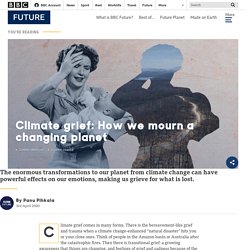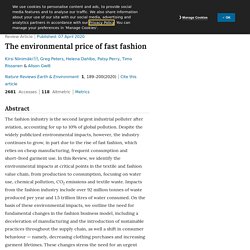

Dave Pollot Transforms Thrift store Paintings with Pop Culture Icons. Artist Dave Pollot ongoing project started in 2012 as a joke between him and his wife.

He challenged himself to take a piece of unwanted artwork, and without changing its style, make it into something that people wanted to own. This started his “obsession” with painting, and he’s been altering art works ever since. Feeling the Magic Behind Sustainable Fashion. Maxine Bédat is a thoughtful entrepreneur.

Her business model is driven by her passion to be a voice for the voiceless in the fashion industry. “We feel the great responsibility to spearhead a movement,” said Bédat, CEO and co-founder of Zady, an online store that champions ethical and sustainable fashion. Launched in 2013, Zady is among the first online retailers that provide a dynamic shopping experience to its customers. With its rich media content, it shares stories on individual brands and how they source and manufacture their products. “Fashion is the world’s second-most polluting industry after oil. Inspired by Africa In 2009, while in law school, Bédat worked in Tanzania for the United Nation’s International Criminal Tribunal for Rwanda, the court that prosecutes people responsible for the Rwandan genocide. She used her free time to explore Africa and deepen her understanding of sustainable economic development.
We feel the great responsibility to spearhead a movement. New Standards. Konbini news - Vieux rideaux, nouvelles fringues : pour une mode responsable avec les Récupérables. Coronavirus: Air pollution and CO2 fall rapidly as virus spreads. Image copyright Getty Images Levels of air pollutants and warming gases over some cities and regions are showing significant drops as coronavirus impacts work and travel.
Like the coin has 2 sides, bad things sometimes are not completely bad. From crisis, we have unexpected pressure, meanwhile it gives some hint maybe. Confront challenge, we had better to stop our hurry walking but rethink frankly and roundly. – sallyhu886
Researchers in New York told the BBC their early results showed carbon monoxide mainly from cars had been reduced by nearly 50% compared with last year.

Emissions of the planet-heating gas CO2 have also fallen sharply. But there are warnings levels could rise rapidly after the pandemic. With global economic activity ramping down as a result of the coronavirus pandemic, it is hardly surprising that emissions of a variety of gases related to energy and transport would be reduced. Scientists say that by May, when CO2 emissions are at their peak thanks to the decomposition of leaves, the levels recorded might be the lowest since the financial crisis over a decade ago.
Image copyright NASA Traffic levels in the city were estimated to be down 35% compared with a year ago. Paris Fashion Week: Facemasks on show amid coronavirus concern. Image copyright Getty Images One show at Paris Fashion Week proved to be unintentionally timely as models wore a range of outfits complete with matching facemasks.

The outfits were shown earlier this week by French designer Marine Serre. The catwalk show took place amid rising concern about the outbreak of coronavirus, which caused markets to fall around the world on Friday. But Serre's collection was designed before the outbreak, and she has used facemasks in her collections before. Her previous show in September also saw models cover their faces with veils or facemasks as part of the designer's spring/summer collection. The masks Serre uses have previously been described by her fashion house as "anti-pollution masks".
Should we ration fashion? Lessons in sustainability from the second world war. A wartime-style economy is often cited as a potential path towards meeting our international carbon emissions agreements.

In debates about the fashion industry, the idea of a shift as radical as the one that took place in the second world war is frequently mooted in conversations about sustainability. Clearly this is a problematic comparison. It is important not to romanticise the violence of war or glamorise the reality of political states of emergency.
But there is a reason the idea keeps being raised. The war is the most recent time in which the economy was overhauled in the face of an existential threat. Clothing was rationed then – a system that changed consumption habits and helped to keep precious materials for use in the war effort. “Make do and mend” was a cultural effort by government to encourage people to fix clothing or modify it to make it feel new. □ Flax, from which linen is made, is one of the oldest continuously cultivated plants in the world. Ancient Egyptians used the finest woven linen as an expression of class and, most notably, wrapped their mummies in it. When grown in its ideal geographica.
Bangladesh overfishing: Almost all species pushed to brink. Image copyright Kabir Uddin/Getty Images.

Climate grief: How we mourn a changing planet - BBC Future. Climate grief comes in many forms.

There is the bereavement-like grief and trauma when a climate change-enhanced “natural disaster” hits you or your close ones. Think of people in the Amazon basin or Australia after the catastrophic fires. Then there is transitional grief: a growing awareness that things are changing, and feelings of grief and sadness because of the many losses involved. The range of things (and creatures) that people mourn for is wide: loss of human, animal and plant life, but also loss of identities, beliefs, and lifestyles. Many people use the term “climate grief” to refer to a wider loss and anxiety related to the overall effects of climate change. The environmental price of fast fashion.
1.United Nations Climate Change.

UN helps fashion industry shift to low carbon. unfccc.int (2018).2.Quantis.